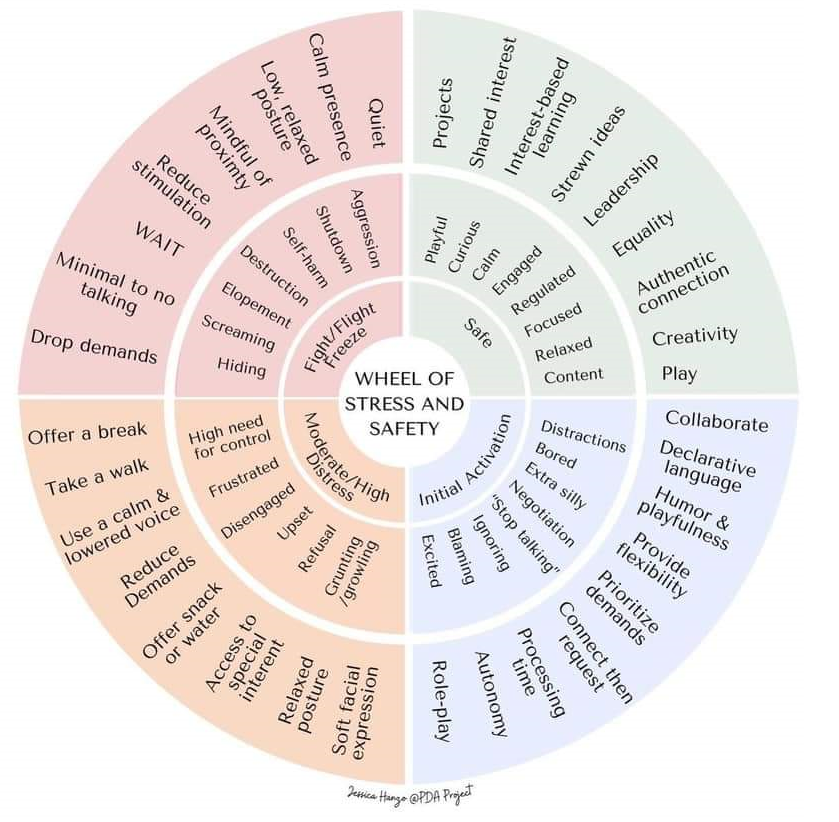My daughter hates learning … or well, maybe the more accurate thing to say is that she hates school and homework, but she loves learning.
She is one of the most curious kids I have ever come across. She is asking questions to the point where you’d go .. who cares about that?! Even for MY ADHD brain.
But lately, whenever I try to get her do her homework or even repeat lessons or prepare for exams – it’s a major tantrum. And I mean MAJOR tantrum. Half an hour, an hour of screaming and crying. Ok girl, this is a 2 minute homework, literally, you sitting here and crying for 1 hour … I dont know, but the Return of investment on this one is … anyhow …
No matter what I would do or say, nothing would help. I started wondering about all the things that could possibly be a problem. Maybe she can’t read well .. dyslexia, maybe she doesn’t understand, language problem, perfectionism issue, needs glasses, maybe she can’t write well, dysgraphia, any other dys, like what is causing this problem?? I would try to think of everything what the issue could possibly be.
At times I got frustrated with her .. “just get it over with, it’s freaking 5 minutes of work!”
I called my friend who has the same job as me and I asked her what she thinks the problem could be and she went down the same routes as me. And then I told her, you know, isn’t it weird that I have always been known by my students to be able to turn their learning problems around and yet I can’t figure out my own child? What’s wrong with me? What’s wrong with ME? Not, what’s wrong with her!!
Don’t Blame The Plants If They Don’t Grow In Your Garden. Tend to the soil, don’t blame the plant!
So I took a step back and asked myself where did I go wrong? And I understood where I went wrong. I tried to make her learn like the school expected it from her, because after all she has to learn how to deal with the system, right?
Yea, so tell me, why don’t you want to learn the list of 50 words all on one page black on white when you are just learning how to decipher words at your age!
Or yea why don’t you want to copy the 5 lines that are written there on another piece of paper, while sitting nicely at your desk without any distractions around you when you are just learning how to write. Yea, why?
So tell me why you don’t want to write all those words that you can’t even read yet because they didn’t teach you the whole alphabet yet at this point?
So tell me, why you don’t care to do your maths homework when they describe a math problem using 2 lines of writing – but you can’t even read yet. But you wish you could read and you are trying to but it takes too long and then you don’t get it and then you get frustrated and then you don’t feel like even trying the rest of the actual work is a pain.
Yea so tell me why? You see, my daughter always loved writing – before school! Even when she didn’t know how to write yet. She would take things I wrote and copy it – just for the fun of it. And she would copy it very well. She loved arabic and chinese writing. Who can read that? Noone, but she loved writing it … for her it was like painting. She saw the calligraphy and thought it looked beautiful and she “painted” it.
She saw, she drew. She knew how to write before she knew how to write, if that makes sense. She loved letters, she was interested in all of it. I used sandboxes with her where she would copy letters, writing in the sand, I would do a lot sensory activities with her when I introduced letters to her at home when she was little. No pressure. Just because she saw my teaching material at home and wanted to know. We had so much fun exploring things.
And she understood quickly, any concept really.
And then she entered school… and it all fell apart. Suddenly she didn’t like reading and writing anymore – is an understatement. And now we came to a point where she blocked completely.
She would become obsessed with not making mistakes, she would be obssessed with writing so clean that the smallest of mistakes she would cry and frantically look for an eraser or rip out pages of her notebook.
It broke my heart. Everything I stand for, everything I fight for when I train teachers, everything I have taught my kids ever since they have been babies … I felt the school broke it. I felt like I failed my own children. I felt like I put them in the wrong school. But the problem is that this was already one of the best schools …
So I see my child throwing those tantrums and I feel helpless. When I talked to the teachers they seem nice, some of them, but they have to follow their programs and what the state dictates or the admin dictates … some teachers didn’t seem to care actually.
In that moment it was like I remembered who I was for my students. So if I can’t be a teacher in that class, let me be the teacher outside of the class …
I looked at the stuff she had to learn, threw it in the corner and left it there. I took some of my old teaching material … Montessori cards, sensory things, I made new things …
I would like you to have a look at the difference in the methodology .. and the reaction of my daugher! The things I will tell you that I did are nothing revolutionary!! Absolutely not! They are not a new invention, they have nothing extraordinary in them, neither do I find them somewhat creative! And they are easy to implement in a day to day classroom. I know, because I have done that!
1. Here is a list with words to read and learn …. boring as hell. Already she didn’t want to start with that one, but even after she started .. 3 words later she would tell me “I’m tired”. “No, sweetie, you are not tired, you are bored as heck!”
What I did instead: One set of cards with the words she needed to learn … one set of cards with pictures of the words. The word is cat, so one card with a cat picture and one card with the word cat written on it. Nothing revolutionary, easy to make, stays forever if laminated.
I spread all the words on the floor left of her, the pictures right of her.
Read, the word and find the right picture. End of the story. Easy as can be. She spent the next 30 minutes, without even whining once, reading words, matching and neatly arranging them next to each other. Not only did she read 50 words, she also asked me if I have more cards and when I said no she asked if we can do that again the next day. And the next day she actually came to me and asked if we could “play that game we played yesterday!”
Does this sound hard to implement in the class?
2. Copy the following text (6 lines) into your copybook. Snoring after 2 words, her confusing lines and copying the wrong line, frustration because she has to erase and redo …
My version … Take the dictation. Cut the lines with scissors so you have 6 pieces of paper. Place them in 6 different places in the room. Her paper to write on is on the desk.
She has to get up and go to the first piece and remember the word, go back to her desk and write it. She can go back and forth as many times as she likes. You can remember the whole thing in one go, that’s fine. You want to get up for every letter, that’s fine, too. You don’t want to walk, well, then run. Let’s time it. Can you beat your own time? Don’t feel like walking or crawling, how about bear walk? How about jumping …
Hard to implement in your class? Maybe yes, they would get excited, right. If your class is getting excited easily keep it calm and just have them walk, but get them moving! And learn how to teach them boundaries for such activities, before you even start them and then tell me it’s not working!!
3. There are 4 seasons … spring summer autumn winter …. nice. how about taking the whole lesson outside? Let’s go find a tree. How does it look like, draw it, collect leaves, make a poster with nature things .. i don’t know, get creative! Who wants to learn with flashcards!
Hard to do? Only if your admin is not supportive and doesnt let you take your lessons outside!
4. Worksheet: All a mixture of letters of the entire alphabet .. circle the letter A. She is missing half the As because she is seeing 30 letters at the same time so that after a while they become blurry and boring and she gets tired to even look for more. So she will not find all the letters, not because she doesn’t recognize them but because her eyes are getting tired of them!
Me: big tub with anything in it … sand, ripped paper .. depending how much of a mess I can deal with that day … have small laminated alphabet cards and hide them in the tubs. Now let the kids find the thing you want them to find by using their hands or brushes or spoons or whatever …
Not easy to do in a classroom? Yea I get, that it can get messy with some kids wanting to throw the sand around, but this one is on you to teach them beforehand: the boundaries …
And follow through with your consequences … You mess it up, we stop the game and I will give you those wonderful worksheets to circle the letters instead! And do stop the game and do give the boring workheet! So for the next time they will know you are not kidding – until they understand it!
And for those of you who are already looking for saying something to defend the worksheet … yes, it’s awesome to teach them concentration and to stay focused … but if you goal is letter recognition and not enhance concentration … I think you get the argument.
5. Learning the difference between nouns, verbs and adjectives … worksheet with a grammar book style explanation for adults what a noun, verb and adjective is … she didn’t get it. I wouldn’t either, even as an adult!
Me .. colour coding nouns, verbs and adjectives … keeping things simple … a noun is something you can see and touch. For now I leave the “a noun can be an idea” aside because she is still young and the examples in her text book are not dealing with these concepts yet, so why would I add that. Break things down into simple steps and know the priorities of what needs to be taught at what stage!
Verbs are things we do and adjectives is how things are. Children’s language!
Nouns in our world are red, verbs are green and adjectives are pink. Write a whole bunch of words on papers, cut them up, throw them in a bag. Have 3 posters (nouns, verbs, adjectives, colour coded) in the room, each one in another corner … kiddo takes one card out of the bag and has to run to the right poster. You have 25 kids .. one kid takes the card, all of them have to run (or walk) to the right poster.
It took her just one game to fully understand the concept. As opposed to hours of explanations on paper.
Hard to implement? Come on! These exercises are so easy and a no brainer. You don’t need to be creative for those. But you get them moving! Get them moving, get them to collaborate with each other, let them research, make them active!! That is the whole secret!
And once in a while also tell them WHY they have to know things. Why would you even want to care about nouns and verbs and all those things, it’s boring!! I don’t want to learn that! Yes, but you see, here is why you will need it … it will still suck to learn but at least you know that you will need it someday and the defiant behavior will maybe not disappear but get less. Make things relatable for them.
6. Ever thought about sign language? Instead of holding up a flashcard and drilling a word into the heads of the kids … use sign language. There are studies out there that have shown that if you teach a new word in a foreign language and you associate it with sign, the kids are more likely to remember it. Sometimes, if they don’t remember the word, but you sign it, they may actually remember the sound as well.
And no matter what the thing is you are doing … brain breaks!! I can not emphazise that enough! I never have my kids sit for any amount of time at the table. We are constantly moving. My kids at home or the kids in my classes.
When my daughter doesnt find the answer to a question … she needs oxygene in her brain (and dopamine), so go jump like a frog up and down the hallway, then waddle like a duck, then jump like a kangaroo then come back and let’s try to think again. And there you go …
Great brain breaks for kids with ADHD or any child actually … depending on their level of excitement … yoga or breathing exercises … or HIIT movements and dancemoves, especially repetetive ones like shuffle dance. Balancing exercises … But anything that creates dopamine really.
And then don’t forget to give high fives and recognize their efforts right after they have done them, not 1 hour down the line. Immediate recognition is what helps the ADHD brain.
There are 1000000000 ways to teach. Worksheets are just one of them. Those are just a few examples and like I said, nothing extraordinary. I can come up with other things, but these ones are easy to implement and effective at the same time.
Don’t get me wrong, every method has it’s place … and time … I’m not against worksheets. But something teachers often did not understand yet is that they are competing against video games, instant gratification from all corners, fun and entertainment everywhere.
Now I’m not telling you to play the clown. You don’t have to. But you need to be able to capture them. And you will never get there with ugly text books, boring texts and lists and black and white worksheets.
Oh no sorry, let me rephrase that!!! ADMINS and Education ministers …
did not understand !!!…. many things and sometimes you need to give your teachers the freedom they need to be able to do their jobs well instead of blocking any valuable and creative idea they come up with to make their kids’ lives easier.
Because how often did you blame the teachers and their lack of commitment … while their enthusiam is met with shaking heads and “no can do’s ” and lack of support .
And then you wonder why they are not commited anymore .. commited to what? Your program? Or commited to teaching the kids, those kids who will one day rule the world and should better get equipped for that?
So far I still have to come across a child, neurodiverent or neurotypical, that did not strive with those – I don’t even want to call them – unconventional methods, because they are not! But I did come across hundreds and thousands of kids – neurodivergent or neurotypical – that did NOT strive under the old style.
Maybe just something to think about…








Leave a comment